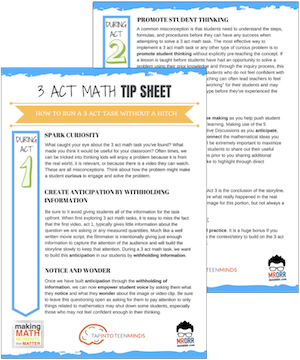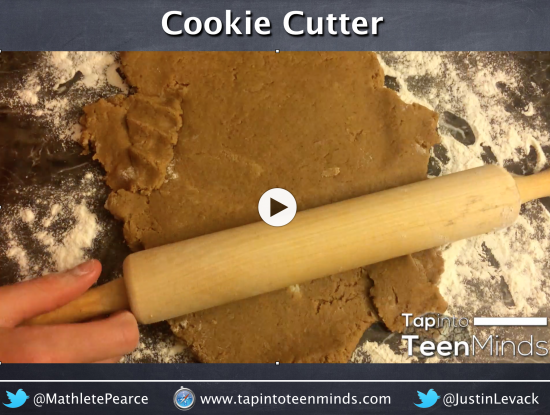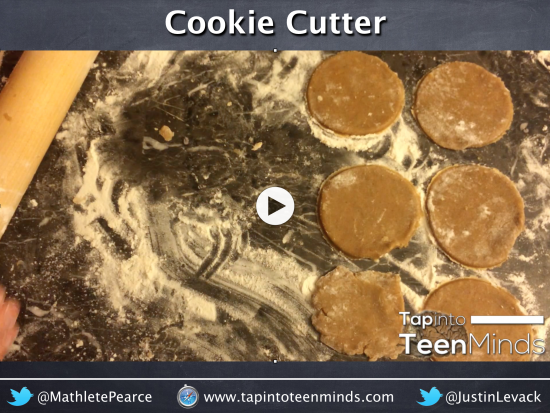Solving Problems Involving Area of Composite Figures
In this 3 act math task, we will explore the measurement strand of the Ontario mathematics curriculum. Specifically, we will look at the area of composite figures including the area of a rectangle and the area of a circle.
Act 1: Introducing the Problem
Making Cookie Dough, Rolling Dough and Cookie Cutting
In the first act of this real world math problem, we show students the video of cookie dough being mixed and rolled with a rolling pin. The cookies are then cut using a circular cookie cutter in a very particular fashion.
After showing the video, give students some time to brainstorm the possible questions that we could ask in this situation.
At our recent MYCI Learning Fair professional development sessions, we had some great questions come from the participating teachers including:
- How many more cookies can we make with the dough that is left over?
- What is the area of the wasted dough?
- What is the surface area of the granite countertop?
- How much more ingredients do you need if you tripled the recipe?
- If this recipe serves ____, then what must we do to serve 25?
- What is the cost of 1 cookie?
- If you’re selling these cookies at a bake sale, how much should you charge to ensure you earn 40% profit?
- How many calories are in the left-over dough?
- How long did it take to make the cookies?
- What size box do you need to ship x cookies?
- What is the optimal shape box to ship x cookies?
- What shape and dimensions would be the most efficient for the cookies?
After having students share out their ideas and celebrating some of the creative thinking, we then narrow the question down to:
How many more cookies could be made with the leftover dough?
Act 2: Revealing Some Information
Dimensions of the Cookie Cutter
Have your students brainstorm to decide what information they need to determine how many more cookies can be cut from the leftover dough. I find it really fun to get kids taking guesses using a high/low strategy to set a range and then have them narrow down to a specific prediction. Great way to get all learners involved, regardless of their level of comfort with math.
After sharing out predictions and hearing what students feel they need in terms of given information, you can show them the following video or image:
Now that students have some information to work with, they can get to it! Sharing and celebrating different strategies to solve the problem can really help elevate the lesson to a dynamic and innovative learning experience! I try to find a really “messy” solution to celebrate the need for students to brainstorm by writing anything and everything they are thinking rather than worrying about their work being a perfectly organized process.
Act 3: Reveal the Answer
Show How Many Additional Cookies We Get!
Once students have shared out, it is time to experience the solution of this real world problem:
If you would prefer to show an image over the video, here it is:
I really like this task because students should come up with an answer of just over 3 additional cookies from the remaining dough, whereas the Act 3 video shows a little more than 5. Some great discussion comes from this surrounding the extraneous variables that could cause this to happen. Some students will notice immediately as the video plays that the cookie dough looks “thinner” and thus more cookies could be the result. Others may notice that some of the corners of the rectangular dough was missing and should yield less than 3 cookies. With many other variables to take into consideration, this is a great task to get students talking and engaged in your room!
Did you use Cookie Cutter in your classroom? Please share your results in the comments section below!
New to Using 3 Act Math Tasks?
Download the 2-page printable 3 Act Math Tip Sheet to ensure that you have the best start to your journey using 3 Act math Tasks to spark curiosity and fuel sense making in your math classroom!

Share With Your Learning Community:

About Kyle Pearce
I’m Kyle Pearce and I am a former high school math teacher. I’m now the K-12 Mathematics Consultant with the Greater Essex County District School Board, where I uncover creative ways to spark curiosity and fuel sense making in mathematics. Read more.
Access Other Real World Math Tasks
Search More 3 Act Math Tasks
Grade 2 [2.B1.1, 2.B1.3, 2.B2.1, 2.B2.2, 2.B2.3, 2.B2.4, Measurement - M1, Number Sense and Numeration - NS1, Number Sense and Numeration - NS2, Number Sense and Numeration - NS3]
Grade 3 [3.B1.5, 3.B2.1, 3.B2.3, 3.B2.7, Measurement - M1, Number Sense and Numeration - NS1, Number Sense and Numeration - NS3]
Grade 4 [4.B2.1, 4.B2.4, 4.E2.5, 4.E2.6, Measurement - M1, Number Sense and Numeration - NS1, Number Sense and Numeration - NS3, Patterning and Algebra - PA2]
Grade 5 [5.B1.7, 5.B2.9, 5.D1.3, 5.D1.6, 5.E2.6, 5.F1.2, 5.F1.5, Measurement - M1, Measurement - M2, Number Sense and Numeration - NS1, Number Sense and Numeration - NS3, Patterning and Algebra - PA2]
Grade 6 [6.B2.12, 6.B2.9, Data Management and Probability - DP3, Measurement - M1, Measurement - M2, Number Sense and Numeration - NS1, Number Sense and Numeration - NS2, Number Sense and Numeration - NS3, Patterning and Algebra - PA1, Patterning and Algebra - PA2]
Grade 7 [7.B1.3, 7.B1.4, 7.B1.7, 7.B2.2, 7.B2.3, 7.C1.1, 7.C1.2, 7.C1.3, 7.C1.4, 7.D1.6, Data Management and Probability - DP3, Geometry and Spatial Sense - GS1, Measurement - M1, Measurement - M2, Number Sense and Numeration - NS1, Number Sense and Numeration - NS2, Number Sense and Numeration - NS3, Patterning and Algebra - PA1, Patterning and Algebra - PA2]
Grade 8 [8.B1.4, 8.B2.5, 8.C1.1, 8.C1.2, 8.C1.3, 8.C1.4, Data Management and Probability - DP1, Data Management and Probability - DP3, Geometry and Spatial Sense - GS2, Measurement - M1, Measurement - M2, Number Sense and Numeration - NS1, Number Sense and Numeration - NS2, Number Sense and Numeration - NS3, Patterning and Algebra - PA1, Patterning and Algebra - PA2]
Grade 9 [9.B3.5, 9.C3.1, 9.C3.2, 9.C3.3]
Kindergarten [k.15.1, k.15.10, k.15.2]
MAP4C [Mathematical Models - MM1, Mathematical Models - MM2, Mathematical Models - MM3]
MAT1LMAT2LMBF3C [Data Management - DM1, Data Management - DM2, Geometry and Trigonometry - GT1, Geometry and Trigonometry - GT2, Mathematical Models - MM1, Mathematical Models - MM2, Mathematical Models - MM3]
MCF3M [Exponential Functions - EF2, Quadratic Functions - QF1, Quadratic Functions - QF2, Quadratic Functions - QF3, Trigonometric Functions - TF1, Trigonometric Functions - TF3]
MCR3U [Characteristics of Functions - CF1, Characteristics of Functions - CF2, Exponential Functions - EF2, Exponential Functions - EF3, Trigonometric Functions - TF3]
MCT4C [Exponential Functions - EF1, Trigonometric Functions - TF3]
MCV4U [Derivatives and Their Applications - DA2]
MDM4U [Counting and Probability - CP2, Organization of Data For Analysis - DA2, Probability Distributions - PD1, Statistical Analysis - SA1, Statistical Analysis - SA2]
MEL4EMFM1P [Linear Relations - LR1, Linear Relations - LR2, Linear Relations - LR3, Linear Relations - LR4, Measurement and Geometry - MG1, Measurement and Geometry - MG2, Measurement and Geometry - MG3, Number Sense and Algebra - NA1, Number Sense and Algebra - NA2]
MFM2P [Measurement and Trigonometry - MT1, Measurement and Trigonometry - MT2, Measurement and Trigonometry - MT3, Modelling Linear Relations - LR1, Modelling Linear Relations - LR2, Modelling Linear Relations - LR3, Quadratic Relations in y = ax^2 + bx + c Form - QR1, Quadratic Relations in y = ax^2 + bx + c Form - QR2, Quadratic Relations in y = ax^2 + bx + c Form - QR3]
MHF4U [Characteristics of Functions - CF3, Exponential and Logarithmic Functions - EL2, Exponential and Logarithmic Functions - EL3]
MPM1D [AG3, Analytic Geometry - AG1, Analytic Geometry - AG2, LR1, LR2, LR3, MG1, MG2, MG3, NA1, Number Sense and Algebra - NA2]
MPM2D [AG1, AG2, AG3, QR2, Quadratic Relations - QR3, Quadratic Relations - QR4, T2, T3]
Functions [F-BF.1, F-BF.3, F-IF.4, F-LE.1, F-LE.2, F-LE.3, F-TF.5]
Geometry [G-C.5, G-C.8, G-C.9, G-GMD.3, G-GMD.4, G-GPE.4, G-GPE.5, G-GPE.7, G-MG.1, G-MG.2, G-SRT.11]
Grade 1 [1.NBT.4, 1.OA.1, 1.OA.6, 1.OA.A.1, 1.OA.B.3, 1.OA.B.4, 1.OA.C.5, 1.OA.C.6]
Grade 2 [2.NBT.5, 2.NBT.B.5, 2.NBT.B.8, 2.NBT.B.9, 2.OA.2, 2.OA.A.1, 2.OA.B.2]
Grade 3 [3.MD.C.5, 3.NBT.2, 3.NF.1, 3.NF.2, 3.NF.3, 3.NF.A.1, 3.OA.1, 3.OA.5, 3.OA.9]
Grade 4 [4-MD.3, 4.MD.1, 4.MD.2, 4.NBT.6, 4.NF.3, 4.NF.5, 4.NF.6, 4.OA.1, 4.OA.5]
Grade 5 [5.B1.7, 5.D1.3, 5.D1.6, 5.MD.1, 5.MD.3, 5.MD.4, 5.MD.5, 5.NBT.2, 5.NBT.3, 5.NBT.6, 5.NBT.7, 5.NF.1, 5.NF.2, 5.NF.3, 5.NF.4, 5.NF.5, 5.OA.1, 5.OA.2, 5.OA.3]
Grade 6 [6.EE.1, 6.EE.2, 6.EE.5, 6.EE.6, 6.EE.7, 6.G.1, 6.G.2, 6.NS.1, 6.NS.3, 6.NS.6, 6.NS.B.3, 6.NS.C.6, 6.NS.C.7, 6.NS.C.8, 6.RP.1, 6.RP.2, 6.RP.3, 6.RP.A.1, 6.RP.A.2, 6.RP.A.3, 6.RP.A.3.C]
Grade 7 [7.EE.3, 7.EE.4, 7.EE.A.1, 7.G.3, 7.G.4, 7.G.6, 7.NS.A.1, 7.NS.A.2, 7.RP.1, 7.RP.3, 7.RP.A.2.B, 7.RP.A.3, 7.SP.2, 7.SP.5, 7.SP.6]
Grade 8 [8.EE.1, 8.EE.5, 8.EE.6, 8.EE.7, 8.EE.8, 8.F.2, 8.F.3, 8.F.4, 8.F.5, 8.G.5, 8.G.6, 8.G.7, 8.G.9, 8.SP.1]
Grade 9Kindergarten [K.CC.A.1, K.NBT.A.1, K.OA.A.1, K.OA.A.2, K.OA.A.3]
Practice [MP.1, MP.2, MP.3, MP.4, MP.6, MP.7]
Statistics & Probability [S-ID.6, S-MD.4]



Hi there. We did this yesterday and consolidated today. It was really fun and I had a few students who were really engaged that aren’t usually. Thank you! I would like to put it on my class blog and was wondering if I can embed your videos to make it easier to watch. I will also include some video of my class solving it. I will put a link to your post on the blog also.
Hi Erin, sorry just seeing this now. Absolutely go ahead and embed the videos wherever you want. A link back to the resource is definitely appreciated! Would love to add any student exemplars you could provide as well. Glad you enjoyed the task!
Hi @disqus_jws9Bq2QfP:disqus
Glad you found the task useful! Yes, feel free to embed the videos on your blog. Always appreciative of the link back to the original post.
Enjoy an awesome Friday!
What necessary words… super, a magnificent phrase Silagra billigt sverige
Act 2 youtube link is broken 🙁
Hmmm from my end it appears to be working fine. Maybe you had a connection issue or YouTube had an issue on their end?
Hi. I have put in my email to get the cookie cutter resources. Thanks! I can’t seem to find the teaching notes though. It goes straight to my google drive with the three videos and the keynote. Is there something I am doing wrong?
I would love to try this but the download (get resources) isn’t working:( I’ve sent my email and it says I’m subscribed but I can’t seem to get this guide. Would love to give this a go! Thanks
Heather, I had the same problem. Today when I was cleaning out my email, I found the resources in my spam folder. I would check there.
Yes – sometimes the email hits your spam instead of your inbox… definitely safelist our email address!
I got the email, but it was just your newsletter, not the actual resources for this task.
I am trying to download the resources and the button is not working.
It should come to your email. Just checked and it worked for me! 🙂 Let me know.